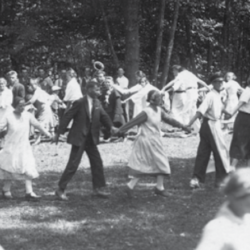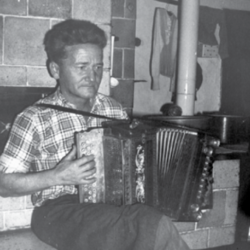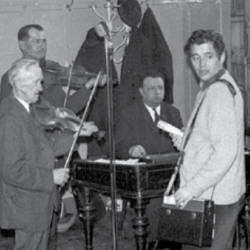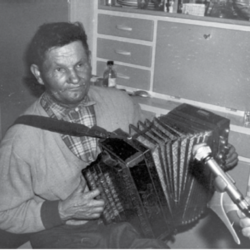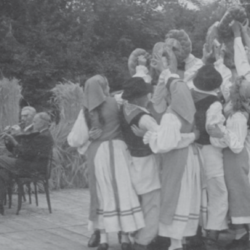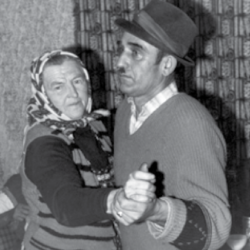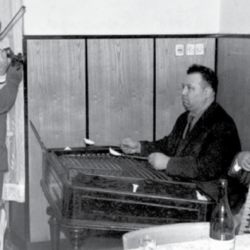Slovenian Folk Dance Music: Prekmurje and the Rába Valley

GNI M 32.631
Recorded: Sakalovci, 1970
Played by: Ištvan Makoš (1934), Janoš Horvat (1939)
This introductory waltz tune symbolically illustrates the fate of music ensembles in Prekmurje and the Rába Valley, where string instruments retained their leading role for a relatively long time and successfully resisted the predominance of the accordion longer than anywhere else in Slovenia. Ultimately, reasons for the greater diversity of instruments can also be sought in the former political affiliation with Hungary, where the accordion did not initially have a predominant role (Rauch, 2009). The musicians adapted this melody from a folk song; they heard it from the old people and turned it into a waltz. The goslarija, as a musicians’ ensemble is called in the Rába Valley, is composed of two musicians playing the violin (gosle) and one playing the piano accordion (tango-fude).
GNI M 26.113
Recorded: Prosečka vas, 1963
Played by: Rudek Gjergjek (1925)
In Prekmurje this group dance, in which dancers run, jump, or walk in single file making serpentine and spiral turns, is danced in a similar way as elsewhere in Slovenia. In Ravensko and Dolinsko it is still danced at feasts following the first mass offered by a newly ordained priest. In some places this dance is called the čindara (an onomatopoetic name), and in other places the kolo. What is interesting is that the musician is playing the tune Seljančica (The Peasant Girl), which was also used in White Carniola for the same dance.
GNI M 31.596
Recorded: Andovci, 1970
Narrated by: Jože Konkolič (1929)
This dance game, in which the partner is selected using a pillow, was also widespread in Prekmurje and the Rába Valley. It was mostly referred to as the vajnkištanc, vajnkištanec, or vankoštanc, based on the Hungarian name. This recording presents a description of the dance form that was once danced in the Rába Valley. When this dance was danced in Goričko and the Rába Valley, all the participants sat and only the one selecting his or her partner with a pillow walked around the room and then danced a solo polka or round dance with the partner.
GNI M 20.113
Recorded: Beltinci, 1955
Played by: Kociprova banda. Sung by: Franc Lebar (1912), Ana Škafar (1918) and members of the Beltinci folkdance group.
This dance, performed to the melody of the song Marko skače (Marko Jumps), was originally a clapping dance; however, little information is available on this dance and it was allegedly forgotten around 1900. Nonetheless some people in the Rába Valley still remembered it in the 1970s (Ramovš 1996: 24). The people of Beltinci probably also knew the original form of the dance and it was precisely this memory that resulted in the development of the new one. As a song accompanying a dance in which a partner is selected, Marko skače seems to be a more recent phenomena, limited only to Beltinci; it was first documented in 1939 at the Maribor festival. All of this further confirms the suspicions that this dance is a result of folklorism.
T 32/A
Recorded: Markovci, 1958
Narrated by: Avgust Časar (1945)
This dance game with one dancer too many was also widespread in northeastern Slovenia. That it was popular and vital even after the Second World War is also confirmed by this recording, in which the dance was described by a thirteen-year-old boy during a 1958 field recording.
GNI M 31.567
Recorded: Gornji Senik, 1970
Played by: Laszlo Šulič (1946)
In the broomstick dance partners change at a sign from the musician. The musician usually shouts beksn, beksl, or bejksl (change), at which point male dancers must change their partners. The dancer that was dancing with the broom up until that point drops the broom and finds himself a partner. The dance continues, and the dancer that ends up without a partner this time around picks up the broom and dances with it. The musician usually played a polka, or sometimes a waltz, with this dance. So this polka may also be a suitable tune for this once very popular dancing game.
GNI M 32.302/A
Recorded: Beltinci, 1970
Played by: Janez Kociper (1909), Jožef Gruškovnjak (1901), Martin Maučec (1916), Martin Bakan (1900), Jožef Kociper (1905), Mihael Nemec (1892), Miško Baranja (1920)
This former guild dance gradually turned into a male group dance in which dancers competed to see who would be better at passing a handkerchief under their knees. The dance was first transcribed in Beltinci, where the local folkdance group has been performing it since before the Second World War.
GNI M 20.090
Recorded: Bogojina, 1955
Played by: Franc Maučec (1912)
One of the researchers that made this recording in 1955 wrote the following in her diary: “A train brought us to Murska Sobota, and from there a bus took us to Bogojina. We searched up and down the long road through the village before we found the singers and the musician. But then we had more than enough to work with” (cited in Kunej, 1999: 223). This recording offers a somewhat different impression of the dance tune because it is only played on the accordion.
GNI M 26.521
Recorded: Odranci, 1964
Played by: wedding musicians.
Sung by: wedding guests.
The trio is usually performed by two female dancers and one male dancer, and is especially typical of Dolinsko in Prekmurje, even though it has also spread elsewhere. According to Ramovš (1996: 39), the dance only appeared after the First World War. It continued to be popular even in the 1960s, at least judging from this recording, which was made at a wedding in Odranci. The recording was not initiated by the researchers; they only documented the wedding and did not have any major influence on it. They also did not have any major influence on the performance practice of either the musicians or dancers, who can also be heard in this recording. The dance tune is very long, and so it had to be slightly abridged for this CD. The recording may have a somewhat distracting background that usually accompanies these types of dance parties (talking, whooping, and singing).
GNI M 31.244
Recorded: Gornji Senik, 1970
Played by: Ferdinand Šulič (1904)
The GNI archive contains a transcription of only one version of the Steirisch from the Rába Valley, even though old people claimed the dance was once widespread in the Rába Valley, and even more information is available for Prekmurje. Judging from the transcribed alpine quatrains published in 1931 in Kalendar Srca Jezušovoga (Almanac of the Sacred Heart; Kühar, 1988: 59), even at the beginning of the twentieth century the Steirisch was danced to sung alpine quatrains, which is an older form of dance practice. The transcribed version from Felsőszölnök is distinguished by multiple figures. The complex dance form is given additional charm by the accompanying tune, which reflects both the performer’s creativity and skills.
GNI M 32.310
Recorded: Beltinci, 1970
Played by: Janez Kociper (1909), Jožef Gruškovnjak (1901), Martin Maučec (1916), Martin Bakan (1900), Jožef Kociper (1905), Mihael Nemec (1892), Miško Baranja (1920)
In 1970, when the institute’s associates wanted to record folkdance melodies, the performers’ dance practice used for the majority of dances at that time was limited to folkdance groups. On that occasion, the Kociper-Baranja Band was composed of two lead fiddles (prim), two violas (kontra), a double bass, two clarinets (C and B clarinets), and a cimbalom (cingule), so it probably does not reflect the sound of the tune to which they used to most frequently dance the šimšrit (seven-step) and other folk dances.
GNI M 31.591
Recorded: Andovci, 1970
Played by: Jože Konkolič (1929)
The popularity of this dance characterized by a motif of seven steps is indicated by its large number of versions, which are similar to the general Slovenian ones in terms of form. They were usually called simšrit or šimšrit (seven-step), and in the Rába Valley they used another name of German origin: ans, cvaj, draj (one, two, three).
GNI M 32.308/B
Recorded: Beltinci, 1970.
Played by: Janez Kociper (1909), Jožef Gruškovnjak (1901), Martin Maučec (1916), Martin Bakan (1900), Jožef Kociper (1905), Mihael Nemec (1892), Miško Baranja (1920)
The Prekmurje versions of the Neukatholischer dance were named as “dance paraphrases” (i.e., based on the opening line of an associated song), but they were also known as the švajcerpolka (Swiss polka), prekmurska polka (Prekmurje polka) and prekmurska zvezda (Prekmurje star). The last name refers to a performance in which the first part involved couples dancing five steps sideways to the center of the circle, and then seven steps sideways back to the edge of the circle, followed by a two-step spins in the second part.
GNI M 20.161
Recorded: Beltinci, 1955
Played by: Matija Kavaš (1908)
The šamarjanka, which is the Prekmurje version of the Styrian mašarjanka, developed as a special dance type from the mazurka subtype known as the varsovienne. In terms of structure, the šamarjanka is the reversed Styrian version of the mašarjanka because the first part of the šamarjanka is actually the same as the second part in the mašarjanka and vice versa. This reversal is also reflected in the name, which developed through the metathesis maš– > šam-. With this recording, in which one can hear the founder and the first leader of the Beltinci folkdance group, we wish to draw attention to the fact that many transcriptions of dance melodies published in Ramovš’ book (1996) were created based on whistling or singing, usually performed by the local that was also demonstrating the dance, and not based on a “perfect” performance by a standard musical group.
GNI M 26.524
Recorded: Odranci, 1964
Played by: wedding musicians.
Sung by: wedding guests.
The dance known by the paraphrase name Šadra, šadra, / vrtanka sta dva, / šadri, šadri, / pogače so tri (Tra La Loo, / The Round Cakes Are Two, / Tra La Lee, / The Cakes Are Three) was also transcribed between 1905 and 1915 by Štefan Kühar, who added a note that it was “surely a dance song at a wedding” (1988: 110). The fact that this šamarjanka was still danced at weddings fifty years later is shown by this recording, made “live” at a wedding in Odranci.
GNI M 31.289
Recorded: Gornji Senik, 1970
Played by: Ferdinand Šulič (1904)
This dance melody is among those to which people danced the mrzulin, as the varsovienne was primarily known in the Rába Valley, using a paraphrase name. The dance transcribed for this melody (GNI Pl 281; Ramovš, 1996: 112–115) is similar in form to the zibenšrit (seven-step) because couples take seven steps (three sideways steps with a second step to bring the feet together, and one without) to the left, and seven to the right. This is followed by three steps to the left and three to the right, in which the pairs make a half-turn each time. In the second part the waltz is danced in a circle moving left.
GNI M 30.899
Recorded: Lipa, 1970
Played by: Jože Horvat (1942)
The sotiš (a kind of schottische) is without doubt one of the best-known folk dances from this area. It was very widespread, very common, and is more or less still danced today. Even though it is increasingly less frequent at traditional occasions such as weddings and other similar dance events, it is also assuming a place in completely new contexts – not only in performances by folkdance groups, but also in the quadrilles performed by graduating high school students in Murska Sobota, when all of the participants also dance a sotiš. This dance melody is most typically heard performed by a folk ensemble with a cimbalom, but here it is performed by a musician playing a diatonic accordion, who (as can be heard in the recording) is playing for a dance.
GNI M 32.304
Recorded: Beltinci, 1970
Played by: Janez Kociper (1909), Jožef Gruškovnjak (1901), Martin Maučec (1916), Martin Bakan (1900), Jožef Kociper (1905), Mihael Nemec (1892), Miško Baranja (1920)
The Prekmurje sotiš comes from the western European schottische, although the two are mostly connected in name only because the schottische (known in Slovenian as the šotiš) involves clapping and stamping on the floor. The basic dance pattern, which consists of two triple steps and a four-step turn, is the same in almost all versions. Only in rare cases is the clapping also transcribed. Many of the transcribed versions of the dance differ primarily in the direction in which the dance is performed and how the couples hold one another while dancing.
GNI M 26.106
Recorded: Prosečka vas, 1963
Played by: Rudek Gjergjek (1925)
The Spitzpolka is a two-part dance in which the first part involves stamping on the floor, clapping, or shaking a finger, and the second part involves two-step spins. Among other names it is also known as the vrablječek (little sparrow) because in some places the dancers change partners and the extra dancer that remains alone is called the vrabec (sparrow) and must dance with a broom.
GNI M 20.121
Recorded: Beltinci, 1955
Sung by: Ana Škafar (1918), Franc Lebar (1912)
Among the earliest tape recordings kept in the GNI audio archive is this recording, to which a “dance paraphrase” of the shoemaker polka is sung. It was sung by two informants, who danced most of the dances performed in Beltinci and the surrounding area for the researcher, Marija Šuštar, in 1955.
GNI M 32.305
Recorded: Beltinci, 1970
Played by: Janez Kociper (1909), Jožef Gruškovnjak (1901), Martin Maučec (1916), Martin Bakan (1900), Jožef Kociper (1905), Mihael Nemec (1892), Miško Baranja (1920)
The shoemaker polka is a pantomime dance in which the dancers’ movements imitate a shoemaker’s work. A special feature of the Prekmurje versions of the dance is that the female dancer stands, usually resting a foot on the knee of the kneeling male dancer.
GNI M 20.088
Recorded: Bogojina, 1955
Played by: Franc Maučec (1912)
The točak (hop polka) is a dance that involves bouncing forwards with the feet apart, which is supposedly derived from former female fertility dances (Ramovš 1996: 184). The main region where this type of dance is practiced is northeast Slovenia. The hopping in the first part of the dance is followed by two-step spins, which is strongly associated with the type of hop polka known as the rašpla, which is of more recent origin.
GNI M 32.633
Recorded: Sakalovci, 1970
Played by: Ištvan Makoš (1934), Janoš Horvat (1939)
In the Rába Valley the točak (hop polka) is known as the rozinka, named after the song Rozinka (or Trzinka, both ‘Theresa’), whose melody it is also danced to in Prekmurje.
GNI M 21.691
Recorded: Bodonci, 1957
Played by: Ludvik Novak. Sung by: Olga Cigüt
This dance, which was known throughout Prekmurje and the Rába Valley, is characteristic of the broader Pannonian region (it was also known in Burgenland, Austria and in Međimurje, Croatia). It is named after the song that it was danced to. This recording of the dance melody will be welcomed by everyone that was not satisfied by the melody of this dance published by Ramovš (1996: 218), which was in unison and ended on the note G.
GNI M 30.888
Recorded: Lipa, 1970
Played by: Jože Horvat (1942)
The gula čardaš is yet another name for the dance that was generally named after the first line of the song Ja sam sirota (I’m an Orphan) or simply Sirotica (The Orphan). Based on its form, the dance belongs to the same group of dances as Po zelenoj trati (Along the Green Meadow); both types of dances are characterized by the initial position, in which one dancer stands behind the other. This recording also serves as a musical illustration to the dance published by Ramovš (1996: 233–235).
GNI M 31.246
Recorded: Gornji Senik, 1970
Played by: Ferdinand Šulič (1904)
This dance, known in the Rába Valley only as Rezka (Theresa), had various names in the Goričko region of Prekmurje: rezlpolka or rejzpolka (Theresa polka), trezlin (Theresa) or špancirpolka (Spazierpolka; literally, ‘walking polka’). The last name best describes the way it is performed because the couples move forward (or walk) in a circle in the first part. This type of dance is also characterized by the couple standing one in front of the other, holding both hands.
GNI M 32.295/A
Recorded: Nemčavci, 1970
Played by: Trio Baranja
Alongside the polka, the waltz has been the main dance since the First World War at dances in the countryside. The waltz as an alternating sung and instrumental dance, in which couples sang and then danced while walking forward in a circle, was unique to Beltinci. Although the Beltinci špancervalcer (walking waltz), also known as Vsaka ftica je vesela (Every Bird Is Happy), is probably at least partially the result of folklorism, the most common musical practice was for musicians to take the melody of the song and transform it into purely instrumental music (without singing the song), which was then danced to. The dance melody on this CD was also subordinated to this process.
GNI M 31.262
Recorded: Gornji Senik, 1970
Played by: Ferdinand Šulič (1904)
Because it was simpler to perform, the vrtenica (a two-step in which couples turn left or right in place taking normal steps) often replaced the polka. The simple twostep, which is most frequently named the pajeriš (Bavarian polka) or kalamajka (kolomyjka) in Prekmurje and the Rába Valley, was often embellished by adding shaking motions or movement of the body left and right, speeding up the turns, and stamping. The dancers used these techniques to demonstrate their dance skills and physical dexterity.
GNI M 26.108
Recorded: Prosečka vas, 1963
Played by: Rudek Gjergjek (1925)
A source from 1896 states that the polka was also one of the most popular dances among the Slovenians living in the Kingdom of Hungary (Ramovš, 1996: 7). The polka still remains a favorite today. Modern dance melodies in a polka rhythm are too fast for many less skilled dancers today, and so the alternating triple step is omitted and replaced with a two-step full turn, which demands less dancing skill from the dancers.
GNI M 26.530
Recorded: Odranci, 1964
Played by: wedding musicians.
Sung by: wedding guests.
In Prekmurje and the Rába Valley, this kmečki valček (peasant waltz) was most often named the mlinček (little mill), Na bistrem potoku je mlin (There’s a mill on the clear stream), or the mlinarovi ples (miller’s dance) after the song associated with it. Its form is related to versions found elsewhere in Slovenia. This points to its recent origin, often connected with schools, and so it is frequently connected with children’s dance heritage. This recording shows that Ob bistrem potoku je mlin (There’s a Mill along the Clear Stream) was also suitable for adult dances because it was danced at a wedding in Odranci in 1964, where the guests had a great deal of fun and some dancers even sang the well-known lyrics of the song for their own enjoyment.
GNI M 32.311
Recorded: Beltinci, 1970
Played by: Janez Kociper (1909), Jožef Gruškovnjak (1901), Martin Maučec (1916), Martin Bakan (1900), Jožef Kociper (1905), Mihael Nemec (1892), Miško
Baranja (1920)
The drmač (shaker) is exceptional in Slovenian dance heritage because it was known only in Beltinci and its vicinity. The characteristic first part, which is danced while shaking the body, is reminiscent of movement while riding a horse, which probably contributed to naming the dance Kak je Törk s Kaniže šou or Da je Törk s Kaniže šou (How the Turk Left Kanizsa). Today it is known as the drmač, a more recent and more established name of Croatian origin that is believed to have been introduced by seasonal workers from Croatia. The Croatian name for the dance is the drmeš and its essential characteristic is also shaking the body (Ramovš, 1996: 282).
GNI M 31.252
Recorded: Gornji Senik, 1970
Played by: Ferdinand Šulič (1904)
There are not many influences of Hungarian dance heritage in Slovenia. Among the Hungarian dances, the Slovenians primarily danced the csárdás, but in a more basic and simplified form. Simplification affected not only the dance, but also the accompanying music. Although the sound of the csárdás melody is closely connected with the performance practice of instrumental ensembles consisting of string instruments, especially various members of the violin family and the cimbalom, Slovenians also danced the csárdás to the accompaniment of just the accordion.
GNI M 20.112
Recorded: Beltinci, 1955
Played by: The Kociper Band
The Slovenians danced the csárdás in a simplified form: in the first part, couples repeated a sequence of two steps with another step to bring the feet together to the right and left, which they performed while rocking vertically, and in the second part they turned in place to the left or right. The turning was performed with either bent knees or running steps. This recording was the basis for the dance transcription published in Ramovš’ book (1996: 296).
GNI M 32.642
Recorded: Sakalovci, 1970
Played by: Ištvan Makoš (1934), Janoš Horvat (1939)
In addition to the csárdás, yet another dance of Hungarian origin was recorded among the Slovenians in Goričko and the Rába Valley. All of the informants were clearly aware that the djereberoužam (Hung. Gyere be rózsám ‘Come Inside, My Love’) was danced to “Hungarian music” (vogrska nota).
GNI DAT 97
Recorded: Gančani, 1999
Played by: Ludvik Šuklar (1923)
This CD concludes with a more recent recording made at the end of the twentieth century for which the recording medium was already digital and no longer analogue, like the rest of the recordings on this CD, which were tape recorded. This symbolically concludes the CD not only in terms of technology, but also content. Specifically, weddings were one of the last dance venues where the opportunity to spontaneously dance in the “old style” was preserved last into the second half of the twentieth century. Weddings formerly concluded with the musicians serenading the wedding guests part of the way home from the feast, usually with a march or a polka.
Rebeka Kunej: Ethnochoreological Study of Prekmurje and the Rába Valley
We cannot imagine an aural impression of Slovenian instrumental folkdance music today without tunes from northeastern Slovenia. Nonetheless, it is surprising that in Slovenian ethnochoreological studies this area was marked by marginality due to its physical remoteness from the center, as well as the exclusivity resulting from this marginality. The territory on the left bank of the Mura River differed from other Slovenian regions not only in its geographical features, which in past centuries were much more insurmountable than today, but also the political and administrative history, which subordinated the Slovenians living on the left bank of the Mura River to the Hungarian crown, thus separating them from the rest of the Slovenians.
There is very little information on the nineteenth-century dance tradition of Slovenians in Prekmurje and the Rába Valley. In his 1829 book Croaten und Wenden in Ungarn (Croatians and Wends in Hungary), Johann von Csaplovics wrote that at that time “folk” dances had already been forgotten and that only the “ordinary” Hungarian and Styrian or German dances were performed (cited in Ramovš, 1996: 7); Valentin Bellosics wrote similarly in 1896 in the fourth volume of Die österreichischungarische Monarchie in Wort und Bild (The Austro-Hungarian Monarchy in Words and Pictures): “the Slovenians living in Hungary prefer to dance the Styrian turner (Dreher) and the csárdás, but also the polka” (cited in Ramovš, 1996: 7).
The dance tradition of the Slovenians living in this area was studied much later on, in close cooperation with the activities at the Institute of Ethnomusicology (GNI) in the second half of the twentieth century. The institute’s founder, ethnomusicologist France Marolt, had already encountered the dance tradition of Prekmurje – specifically, Beltinci – in 1938 during preparations for the Folklore Festival, which took place in Maribor in 1939. After making inquiries about Beltinci folk dances, Marolt made contact with a local man, Matija Kavaš, who gathered a few other locals to perform at the Maribor festival, where they presented some of their dances to the accompaniment of the Kociper Band. At that time, Marolt did not study the dance tradition of Beltinci in great depth and he also did not publish his findings in any journals, but his interest did leave a trace in the tradition, and in the awareness and attitude of the people of Beltinci towards their own folkdance heritage.
The first serious ethnochoreological studies were not conducted until April 1946, when France Marolt and Marija Šuštar transcribed dances in Beltinci. At the same time, their study of dance tradition was also useful in applied ethnochoreology: based on the music and choreological records from that time, the Panonska suita (Pannonian Suite) was created. This was one of the first items on the program of the newly established Ljubljana folkdance group (now named the France Marolt Student Folkdance Group). This stage performance included a musical adaptation by France Marolt and choreography by Marija Šuštar for the following three dances: Po zelenoj trati (Along the Green Meadow), the šamarjanka (varsovienne), and Marko skače (Marko Jumps) (Šuštar, 1968: 7). Ethnochoreological research in Prekmurje, or the Beltinci dance transcriptions, were the first items in the dance archives at GNI and the first systematic studies of Slovenian folkdances in the second half of the twentieth century. The institute’s dance researchers conducted several studies in Prekmurje: Tončka Marolt in Beltinci in 1951, and Marija Šuštar in Beltinci in 1955, in the northern part of Dolinsko and on the southwestern edge of Goričko in 1957, in northern Goričko in 1958, and in southern Goričko and eastern Ravensko in 1963. Mirko Ramovš conducted research in western Goričko in 1970, in Gornji Petrovci in 1973 and 1976, and in Velika Polana in 1977 and 2003. Ramovš was also the first to conduct ethnochoreological studies among the Slovenians in the Rába Valley in the small triangle of nine villages between the Slovenian and Austrian border up to Szentgotthárd in Hungary (from 1970 to 1973).
Prekmurje folkdance forms were primarily presented on the basis of dances studied in Beltinci. When Marija Šuštar published her book Slovenski ljudski plesi Prekmurja (Slovenian Folkdances in Prekmurje) in 1968, she fell into the same trap that she also drew attention to in the book. In the foreword itself, the author established that “the people of Prekmurje themselves claim there are good and enthusiastic dancers in Goričko, whereas in Ravensko they prefer to sing. However, Prekmurje dances became known primarily thanks to a dance group from Ravensko composed of Beltinci locals because they often performed at various events. Of course its program does not include all the dances practiced in Prekmurje.” However, the fact is that Šuštar went on to publish twelve Prekmurje dances in her book, eleven of which she transcribed in Beltinci in 1955 and 1957, and only one in Hotiza. Thus she herself contributed to the fact that even today Prekmurje folkdance heritage is only connected with that of Beltinci. This mistake was not even corrected in the Slovenian folkdance anthology Plesat me pelji (Take Me Dancing; Ramovš, 1980), in which only one dance from Beltinci (i.e., Vsaka ptica je vesela ‘Every Bird Is Happy’) is replaced by the pajeriš (Bavarian polka) from Pertoča. As far as was possible and as far as the dance transcriptions allowed it, a more comprehensive view of the Prekmurje and Rába Valley dance tradition was provided by the dance collection Polka je ukazana. Plesno izročilo na Slovenskem: Prekmurje in Porabje (A Polka Is Ordered. Dance Heritage in Slovenia: Prekmurje and the Rába Valley; Ramovš, 1996). Therefore even in today’s presentation of dance tradition and the related instrumental folkdance music one cannot completely avoid focusing on the narrow area of Beltinci because today it is practically completely impossible to study these musical and dance practices due to the historicity of this phenomenon.
Because of the interpretations and reinterpretations of dance and music sources and transcriptions, the attitude towards folkdance and the appertaining dance music in Prekmurje is often one-sided, extremely sentimental, and frequently connected with melancholy and nostalgia. Thus the musical past of the area studied may be much more complex and rich than most people are aware of today but, despite knowing this and the desire to discover the unknown, when preparing this CD the authors were limited by the material existence of intangible heritage in this area. Despite our desire to go beyond the fairly stereotypical form of music ensembles and the soundscape of Prekmurje and Rába Valley folkdances, our work was greatly limited to the material recorded by our predecessors. The dance tunes selected for the CD were limited not only by what previous researchers had studied and recorded in the past, but also by the technical expectations of today’s audience. Regardless of its documentary value, the recorded audio material must be brought closer to modern listeners and adjusted to their demands and aesthetics. Nevertheless, some recordings, especially those from the early period of sound recording, are technically deficient due to the poor-quality recording equipment of the time. Despite its testimonial value, some material was not selected for the CD because noise, distortion, and other distracting background sounds made it impossible to bring them close enough to current audio release standards.
This CD provides an insight into the character of the Slovenian folk instrumental music in Prekmurje and the Rába Valley, as can be found in the audio archive at the Institute of Ethnomusicology, whose goal in the past was to collect and study Slovenian folk heritage. Thus a considerable amount of material recorded among the Slovenians living in Hungary was included on the CD; what is missing is at least an illustrative example of the soundscape of the Hungarian folk music in Slovenia because in the past the institute did not study the folk music and dance of minorities.
Not taking into account the wax-cylinder recordings made by foreign researchers, the first folk-music recordings in Prekmurje were made on 18 December 1955. These tape recordings are among the oldest in the GNI audio archive. They were made using a Magnemite portable recorder, model 610C, designed especially for fieldwork, which the institute acquired a year before. The importance of these recordings is also confirmed by the fact that, worldwide, field recordings on tape only came into use after the Second World War; the first such portable tape recorders did not appear until 1948 (Kunej, 1998: 184). The field recordings that various field research teams made in 1955, 1957–58, 1963–64, 1970–72, and 1999 in Adrijanci, Andovci (Orfalu, Hungary), Beltinci, Bodonci, Bogojina, Gančani, Gornji Senik (Felsőszölnök, Hungary), Hotiza, Lipa, Mali Šalovci, Markovci, Nemčavci, Odranci, Prosečka Vas, Sakalovci (Szakonyfalu, Hungary), Šalovci, and Verice (Kétvölgy, Hungary) were used to illustrate the Slovenian folkdance tunes of Prekmurje and the Rába Valley. The recordings of all the instrumental ensembles in the area that can be found in the archive are included on the CD, but the fact remains that not all the possible ensembles were recorded during field recording (cf. Rauch 2009). Nonetheless, the wish remains to at least slightly improve the impression that the only soundscape of the Prekmurje dance tunes is the one offered by today’s popular music, which seeks inspiration in the folk music of this area.
This CD only provides insight into the character of Slovenian folk tunes of Prekmurje and the Rába Valley rather than a comprehensive overview; at the same time, it also represents a musical illustration to Ramovš’ 1996 book containing transcriptions of Prekmurje and Rába Valley folk dances. The audio mix that it produces is yet another reflection of the past creativity of the Slovenian people. It should encourage understanding of the past and creative thinking in the present, which will be able to enrich today’s diverse music practices.
